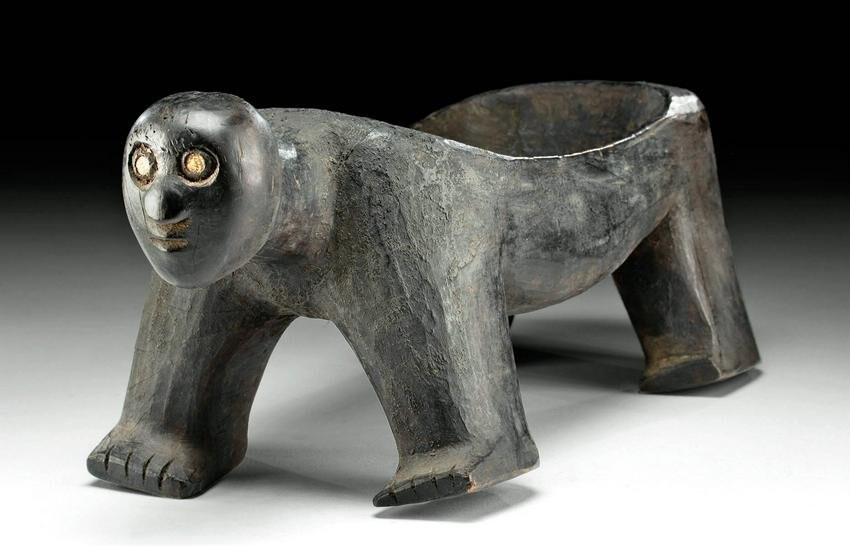19th C. Philippine Ifugao Wood Ritual Duyu (Bowl)
Southeast Asia, Philippines, Northern Luzon, Ifugao province, Ifugao culture, ca. early to mid-20th century CE. A remarkable bowl known as a duyu, skillfully carved from a single block of wood to present in the form of a human. Supported by their thick arms and legs, the fascinating figure exhibits a lengthy plank and sloped back that has been hollowed out to serve as the basin of the bowl. An elongated neck juts forward from one end, displaying a round head and stylized visage of huge, nacre shell inlay eyes, a broad, flat nose, and a gentle smile. Duyus were ritualistic vessels for sipping rice wine or presenting offerings. These ceremonial bowls were polished with animal fat and developed dark patinas from smoke as they were often kept near a hearth, as we see in the rich espresso-hued patina of this fine example! Size: 15" L x 6.4" W x 6.3" H (38.1 cm x 16.3 cm x 16 cm)
The Ifugao people are an ethnic group inhabiting the Ifugao Province of the Philippines. The term Ifugao is derived from "ipugo" meaning earth people, mortals, or humans, as distinguished from spirit and deities. The group is known for headhunting - taking a skull and preserving it after killing someone - which was practiced around the world throughout history, from Oceania to Europe and Mesoamerica. Anthropologists became intensely interested in the practice, especially in the early to mid-20th century, and developed a general theory about the meaning of headhunting: to define hierarchy and power within communities, based on the idea that the head contained the life force of the individual, and that capturing it allowed its holder to contain that power. For the Ifugao, the taken head was a prized object. The Ifugao mounted heads over their hearths and outside their huts.
Provenance: private Hawaii, USA collection, acquired from 1995 to 2010
All items legal to buy/sell under U.S. Statute covering cultural patrimony Code 2600, CHAPTER 14, and are guaranteed to be as described or your money back.
A Certificate of Authenticity will accompany all winning bids.
PLEASE NOTE: Due to recent increases of shipments being seized by Australian & German customs (even for items with pre-UNESCO provenance), we will no longer ship most antiquities and ancient Chinese art to Australia & Germany. For categories of items that are acceptable to ship to Australia or Germany, please contact us directly or work with your local customs brokerage firm.
Display stands not described as included/custom in the item description are for photography purposes only and will not be included with the item upon shipping.
#168527
Condition Report: Expected nick, chips, and abrasions. A few stable hairline fissures. Otherwise, excellent with nice patina.
View it on
Estimate
Time, Location
Auction House
Southeast Asia, Philippines, Northern Luzon, Ifugao province, Ifugao culture, ca. early to mid-20th century CE. A remarkable bowl known as a duyu, skillfully carved from a single block of wood to present in the form of a human. Supported by their thick arms and legs, the fascinating figure exhibits a lengthy plank and sloped back that has been hollowed out to serve as the basin of the bowl. An elongated neck juts forward from one end, displaying a round head and stylized visage of huge, nacre shell inlay eyes, a broad, flat nose, and a gentle smile. Duyus were ritualistic vessels for sipping rice wine or presenting offerings. These ceremonial bowls were polished with animal fat and developed dark patinas from smoke as they were often kept near a hearth, as we see in the rich espresso-hued patina of this fine example! Size: 15" L x 6.4" W x 6.3" H (38.1 cm x 16.3 cm x 16 cm)
The Ifugao people are an ethnic group inhabiting the Ifugao Province of the Philippines. The term Ifugao is derived from "ipugo" meaning earth people, mortals, or humans, as distinguished from spirit and deities. The group is known for headhunting - taking a skull and preserving it after killing someone - which was practiced around the world throughout history, from Oceania to Europe and Mesoamerica. Anthropologists became intensely interested in the practice, especially in the early to mid-20th century, and developed a general theory about the meaning of headhunting: to define hierarchy and power within communities, based on the idea that the head contained the life force of the individual, and that capturing it allowed its holder to contain that power. For the Ifugao, the taken head was a prized object. The Ifugao mounted heads over their hearths and outside their huts.
Provenance: private Hawaii, USA collection, acquired from 1995 to 2010
All items legal to buy/sell under U.S. Statute covering cultural patrimony Code 2600, CHAPTER 14, and are guaranteed to be as described or your money back.
A Certificate of Authenticity will accompany all winning bids.
PLEASE NOTE: Due to recent increases of shipments being seized by Australian & German customs (even for items with pre-UNESCO provenance), we will no longer ship most antiquities and ancient Chinese art to Australia & Germany. For categories of items that are acceptable to ship to Australia or Germany, please contact us directly or work with your local customs brokerage firm.
Display stands not described as included/custom in the item description are for photography purposes only and will not be included with the item upon shipping.
#168527
Condition Report: Expected nick, chips, and abrasions. A few stable hairline fissures. Otherwise, excellent with nice patina.



